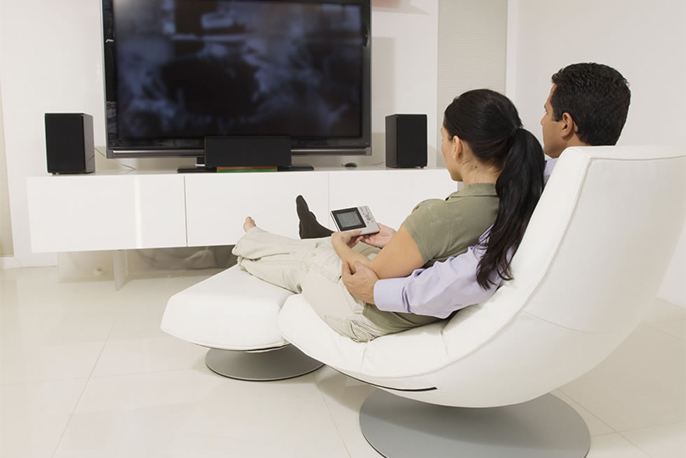
Create a Hollywood-inspired experience at home.
Technology. Love it or hate it, but we cannot live without it. High tech items have become part of our everyday life. They make our lives much easier and more enjoyable whether a Nest thermometer, which can lower and raise the temperature in your home according to your habits and save energy and fuel costs, or a robot vacuum cleaner that knows how to navigate your home’s corners and zigs and zags and cleans well.
Today, new high technology and home theaters have joined forces to offer homeowners a Hollywood-inspired experience, if you have extra room for a wide screen and comfortable seating. The best area of your home to outfit with a theater is a lower-level basement since there’s typically less natural light–good for watching movies or TV.
However, as much as you may think you’d like to do it yourself, undertake this project with help from an expert since costs can mount, and you want to be sure you select equipment that remains up to date and is easy to use. Rob Dzedzy of Media Rooms Inc. in West Chester, Pennsylvania, and interior designer Sharon McCormick of Sharon McCormick Design, LLC, in Durham, Connecticut, share pointers to achieve the best results.
Read on for more information….
#1. Hire an audiovisual (AV) expert to work with you and your designer or architect rather than assemble components yourself. If you want a true theater experience with sound emanating from various parts of the room and other essential components, it’s best to bring in an AV expert. You can find someone skilled by going to the Custom Electric Design and Installation Association Web site (CEDIA).
#2. Research so you know the right questions to ask. Key ones are: How long have they been in business; what are names of clients you may call for recommendations; which products do they consider most important; which manufacturers do they typically work with, and is there any new equipment to know about? Also include the following, according to Dzedzy:
- Increase in 4K resolution. Better audio-video systems “upscale” the video so even standard-high definition (1080p) looks sharper with more colors because of the 4K capability.
- New video-projector systems. A typical projector uses a lamp to shoot the image onto the screen, and lasts between 1,500 and 2,000 hours before it burns out and needs to be replaced. Now LED and laser light source projectors are available that last 20,000 hours or longer.
- Large flat-panel TVs which today are more reasonable in price. They may be as large as 75″ in diameter or greater and are available for indoor and outdoor use. This makes it possible to bring the home theater experience into a family room or outdoor area where a projection video system may not be feasible because of ambient room light, Dzedzy says.
- New audio systems. Dolby’s Atmos uses special speakers to reflect sound off the ceiling for a more real-life theater approach. Dolby Atmos speaker layouts come with surround sound options for two Atmos enabled speakers, or four Atmos enabled speakers and can also include a pair of front wide speakers. Dolby Atmos enabled ceiling speakers (or modules) deliver equivalent performance. Using two speakers of either type will provide a convincing and powerful effect. Using four speakers will offer the optimum sense of audio movement and precision in most rooms.
- Video streaming. When possible, Dzedzy’s firm hardwires the audio video system to a client’s router so streaming is uninterrupted. Sometimes, the system needs to be connected wirelessly.
#3. Know how many will use the room and design accordingly. Most homeowners want seats with arm consoles and a drink/popcorn holder, want them to recline, and step back on risers, so everyone can see. In one theater McCormick designed, which measured 12’ 6” by 23’, she could fit eight seats with two larger for the homeowners. The screen was 56” high with the ceiling height at 10’. Many of Dzedzy’s clients request anywhere from eight to 16 seats. To accommodate that number, a room should measure between 16’ to 20’ wide and 20’ to 30’ long, and the ceiling be 9’ to 10’ high.
#4. Plan for the right floor, wall, and ceiling materials, as well as comfortable seats. A carpet with a good pad underneath is best for floors since it absorbs sounds. Walls can be lined with acoustic-absorbing material that’s wrapped with a decorative fabric. Everything should be dark so it doesn’t reflect light. And the ceiling should be sheetrock or drywall painted, though another option that adds glamour and sparkle is a fiber optic ceiling, similar to stars twinkling in the sky. Mechanicals can be installed in the ceiling if there’s enough height, with beams possibly camouflaging them. All in all, the room should use a combination of absorptive and reflective surfaces for best performance. And be sure to consider comfortable stain-resistant materials on the seats such as faux leather or microfiber.
#5. Include some artificial light. Dzedzy likes to install LED lights along the floor, especially when the floor is graded to form a safe path; in wall sconces to wash walls and artwork such as movie posters; and in recessed cans. Controls can be placed at the owners’ seats to turn them on and off and dim them easily, which nowadays can be done from many smart phones as well.
#6. Don’t forget bells and whistles in the design. Maybe, you want a popcorn and drink machine, curtains to frame the screen, glass porthole windows in doors, cinema-style marquee signs, and digital servers to store movies. Why get up from your chair? The right control system is crucial so with one touch you can start the movie and change channels, volume, dim lights, open or close motorized curtains, and adjust the room’s temperature.
#7. Total wrap cost. The sky’s literally the limit, depending on the level of sophistication you desire—even the type of screen material can vary in price. LED and laser video projectors are slightly higher than the average high quality projector using a traditional lamp. Some run between $8,000 and $15,000. "The prices will come down as more products become available in the market," Dzedzy predicts. Large flat-panel TVs have already come down in price since they were first introduced for about $50,000. Now, you can buy an 85" for about $9,000 and 75" for $3,500, he says. The interior design of the theater can also range dramatically based on finishes.
#8. Parting advice: The best rule of thumb is to set a budget, factor in how often you’ll use the theater, and how it fits into the overall value of your home. You don’t want to price your home out of the market since a home theater is a great addition but won’t appeal to everyone.
Once you’ve brought a bit of Hollywood movie theater design into your home, you can sit back, put your feet up, grab a bag of popcorn and a drink, and watch your favorite flick.
